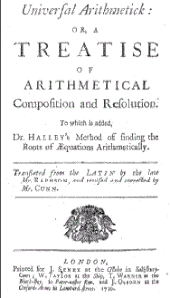

Arithmetica Universalis ("Universal Arithmetic") is a mathematics text by Isaac Newton. Written in Latin, it was edited and published by William Whiston, Newton's successor as Lucasian Professor of Mathematics at the University of Cambridge. The Arithmetica was based on Newton's lecture notes.
Publication history
Whiston's original edition was published in 1707. It was translated into English by Joseph Raphson, who published it in 1720 as the Universal Arithmetick. John Machin published a second Latin edition in 1722.
Lack of credit for the writer
None of these editions credit Newton as author; Newton was unhappy with the publication of the Arithmetica, and so refused to have his name appear. In fact, when Whiston's edition was published, Newton was so upset he considered purchasing all of the copies so he could destroy them.
Content
The Arithmetica touches on algebraic notation, arithmetic, the relationship between geometry and algebra, and the solution of equations. Newton also applied Descartes' rule of signs to imaginary roots. He also offered, without proof, a rule to determine the number of imaginary roots of polynomial equations. A rigorous proof of Newton's counting formula for equations up to and including the fifth degree was published by James Joseph Sylvester in 1864. [1]
References
- ^ Sylvester, J.J. (6 April 1864). "Algebraical Researches, containing a disquisition on Newton's Rule for the Discovery of Imaginary Roots, and an allied Rule applicable to a particular class of Equations, together with a complete invariantive determination of the character of the Roots of the General Equation of the fifth Degree, &c". Philosophical Transactions of the Royal Society. 154: 580–591. Retrieved 29 October 2023.
- The Arithmetica Universalis from the Grace K. Babson Collection, including links to PDFs of English and Latin versions of the Arithmetica
- Centre College Library information on Newton's works
External links
- Arithmetica Universalis (1707), first edition
- Universal Arithmetick (1720), English translation by Joseph Raphson
- Arithmetica Universalis (1722), second edition